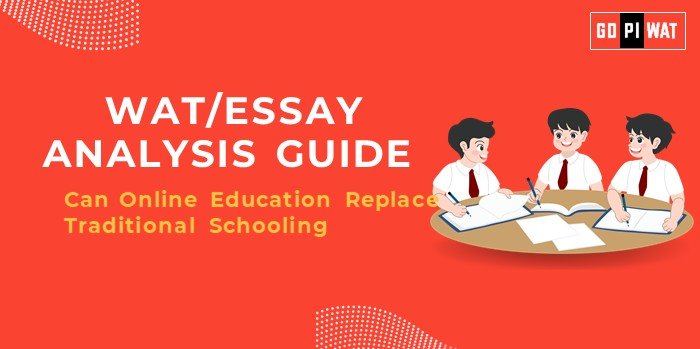📋 WAT Guide: Can Online Education Replace Traditional Schooling?
🌟 Understanding the Topic’s Importance
Online education’s rise challenges the traditional schooling model, raising questions about inclusivity, efficiency, and adaptability. This topic resonates with themes of innovation and digital transformation, crucial for B-school discourse.
📝 Effective Planning and Writing
Planning: 5 minutes | Writing: 20 minutes | Review: 5 minutes.
– 📘 Preparation Tips: Highlight the potential and limitations of both education modes. Use statistics to support arguments.
💡 Introduction Techniques
1. Contrast Approach: “While online education offers flexibility, traditional schooling fosters community and discipline.”
2. Solution-Based Approach: “Blending online and traditional methods may offer the most effective learning outcomes.”
📚 Structuring the Essay Body
- 🏆 Achievements: Highlight accessibility, cost-effectiveness, and global reach.
- ⚖️ Challenges with Comparative Analysis: Discuss the digital divide, lack of experiential learning, and reduced interpersonal skill development.
- 🔮 Future Outlook: Envision a hybrid learning ecosystem leveraging technological advancements.
🔗 Concluding Effectively
1. Balanced Perspective: “While online education can complement traditional methods, replacing schools entirely may undermine holistic development.”
2. Global Comparison: “Learning from Estonia and Finland, a balanced approach integrating digital tools with traditional teaching holds promise.”
📊 Analyzing Successes and Shortcomings
- ✔️ Key Achievements: Accessibility and personalized learning.
- ⚠️ Ongoing Challenges: Equity, infrastructure, and engagement.
- 🌍 Global Context: Robust EdTech adoption in developed countries.
🌱 Recommendations for Sustainable Progress
- 📘 Promote hybrid learning models.
- 📶 Strengthen digital infrastructure.
- 🤝 Focus on interactive and inclusive technologies.
✍️ Sample Short Essays
1. Balanced Perspective:
“The rise of online education has transformed learning, but traditional schooling’s role in fostering social and cognitive skills remains irreplaceable. A hybrid model combining both methods may address their limitations.”
2. Solution-Oriented:
“Online education has revolutionized accessibility, but challenges like the digital divide persist. A hybrid approach leveraging VR and AI could bridge these gaps effectively.”
3. Global Comparison:
“Countries like Finland and Estonia demonstrate that integrating online tools with traditional systems creates a more balanced and inclusive educational framework.”


